Start a custom printing business with Printify
In 2023, the print-on-demand (POD) industry hit an impressive $8.03 billion in market size, playing an important role in the steady growth of eCommerce.
But how can you keep up with all this fast-paced development and innovation? How can you ensure your online store delivers all the latest must-haves and features?
Picture this: A backstage pass to insider data and stats that could redefine the trajectory of your online business. Sounds impossible? Well, let us blow your mind!
We’re bringing you a list of 28 exclusive POD statistics, insights, and trends, delving into customer preferences, emerging patterns, and technological advancements.
This isn’t just industry chatter – these are findings based on our data. Get the inside scoop on what’s shaping the growth of eCommerce and make informed decisions for the future of your business.
Print on Demand industry insights
Let’s start off by looking at general data surrounding the print-on-demand market. From realistic sales expectations to the right mindset, these key insights will help you find the right approach for starting or scaling your online store.
How long does it take to make $1K?
- On average, sellers take 165 days to hit their first $1,000 in revenue. However, successful merchants have managed to reach $1K in less than 118 days.
At first glance, this may seem a long time, but remember, some people give up before getting properly started.
And if we told you today that in under 4 months you could have a business that gives you $1000 a month, every month, risk free, and that this would grow, we think you’d be interested. So how can you bask in eCommerce glory much sooner? Well with our proper guidelines, that’s how.

Success doesn’t happen overnight but is achievable with patience, commitment – and the right tools.
That’s where our in-house statistics and data come in handy. This information lets you adjust your efforts and strategies to skyrocket sales and reach POD success in no time.
How your efforts affect your Print on Demand business
It’s no secret that you have to work hard to reach significant growth for your online business, but we’ve got some golden nuggets that will help you speed up the process and set the right mindset to thrive in the eCommerce industry.
First, look at disappointments as lessons. Not every product turns out to be a bestseller – and that’s okay. You have to embrace these little hiccups like a champ because our data shows that experimentation is key.
High-volume sellers have over 500 listings on average – with multiple items, designs, and variants. And our data shows that
- They published approximately 67 new listings until they hit the 1K GMV.
Try new products, test new graphics, and experiment with different sales tactics. Brainstorm new ideas, preferably late at night, with a nice beverage and lots of cheese. And, who knows, the boldest, most unusual thought might just be your next big win.
And here’s another power move to try – publish frequently and a lot, especially when selling on marketplaces like Etsy and eBay, which are super competitive spaces.
- On average, top sellers publish ten new listings every week. You should aim to do the same, even if it’s just a slight tweak to a design or putting a design on a different product.
The more you bring to the table, the greater your shot at success. It’s like creating a buffet of unique products and designs, catering to the diverse tastes of online shoppers around the world. The more dishes you serve up, the more likely you are to give someone the meal of their dreams.
Last but not least, don’t try to score big with a couple of over-priced items because our data tells us that’s not what successful merchants are doing.
- There are no cash cows. The majority of successful merchants are making most of their revenue from 40% of their listings. The real magic is raking in profits with a bunch of well-priced listings.
More listings mean more opportunities for sales. It’s not just about big-ticket items – it’s about creating a shopping experience where every wallet finds its perfect match.
So, diversify your product range, set those prices right, and watch your online store thrive.
Read more:The 2023 eCommerce Statistics Roundup
Make it happen today!
Insights into products and design trends
The print-on-demand industry offers a vast array of product sizes, colors, materials, and designs just waiting for your creative touch. With fashion trends and consumer whims changing every minute, let’s uncover what to sell and to whom.
Top trends: picking color options for your products
To our surprise, the single-color option reigns supreme among print-on-demand products.
- Items with just one color choice are the stars of the show in both apparel and non-apparel categories.
Why? The simplicity of just one color clicks with customers, making choices a breeze and decisions lightning-fast in specific market segments. Also, sometimes, one color is the only correct choice. Think black for Halloween or red for Valentine’s Day.
- Our data tells us to go for black, white, sand, navy, and sport gray options for your single-color products if you want yours to be among the popular choices. (With black and white taking the lead in t-shirt sales worldwide).
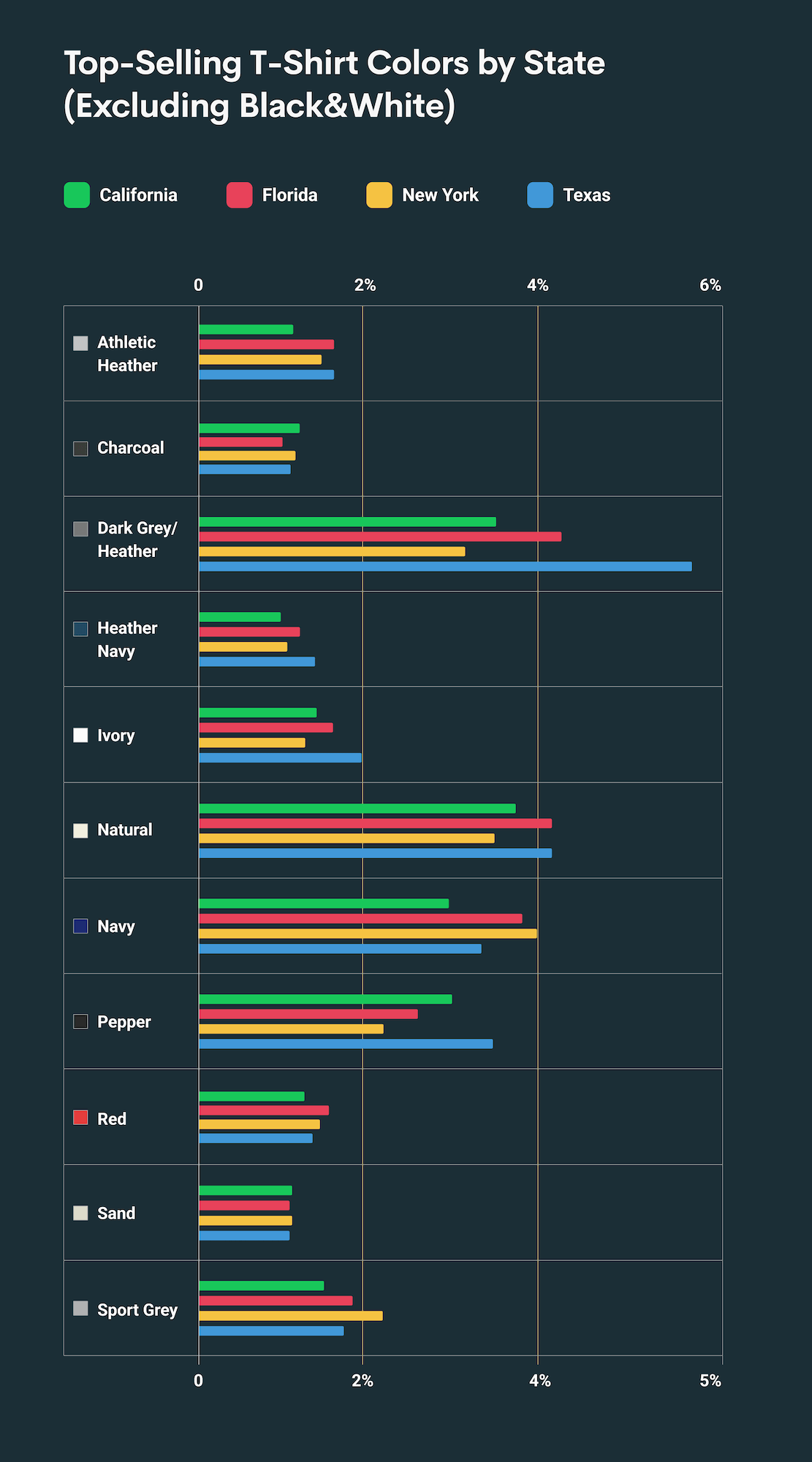
- For non-apparel products, it’s worth matching the seam color with the design – our data shows that it’s something customers appreciate.
But if you’re a fan of colors and variety, don’t worry. There is still a demand for variation. Just remember that simplicity is key in all print-on-demand sales.
- 1-5 is enough. Products offering 1-5 color options outshine those with over five color variations by a whopping 70%.
A concise color palette isn’t just trendy – it’s a magnet for customer engagement and easy purchasing decisions.
- More than five color options are rarely a hit. Over half of non-apparel sales thrive on single-color products.
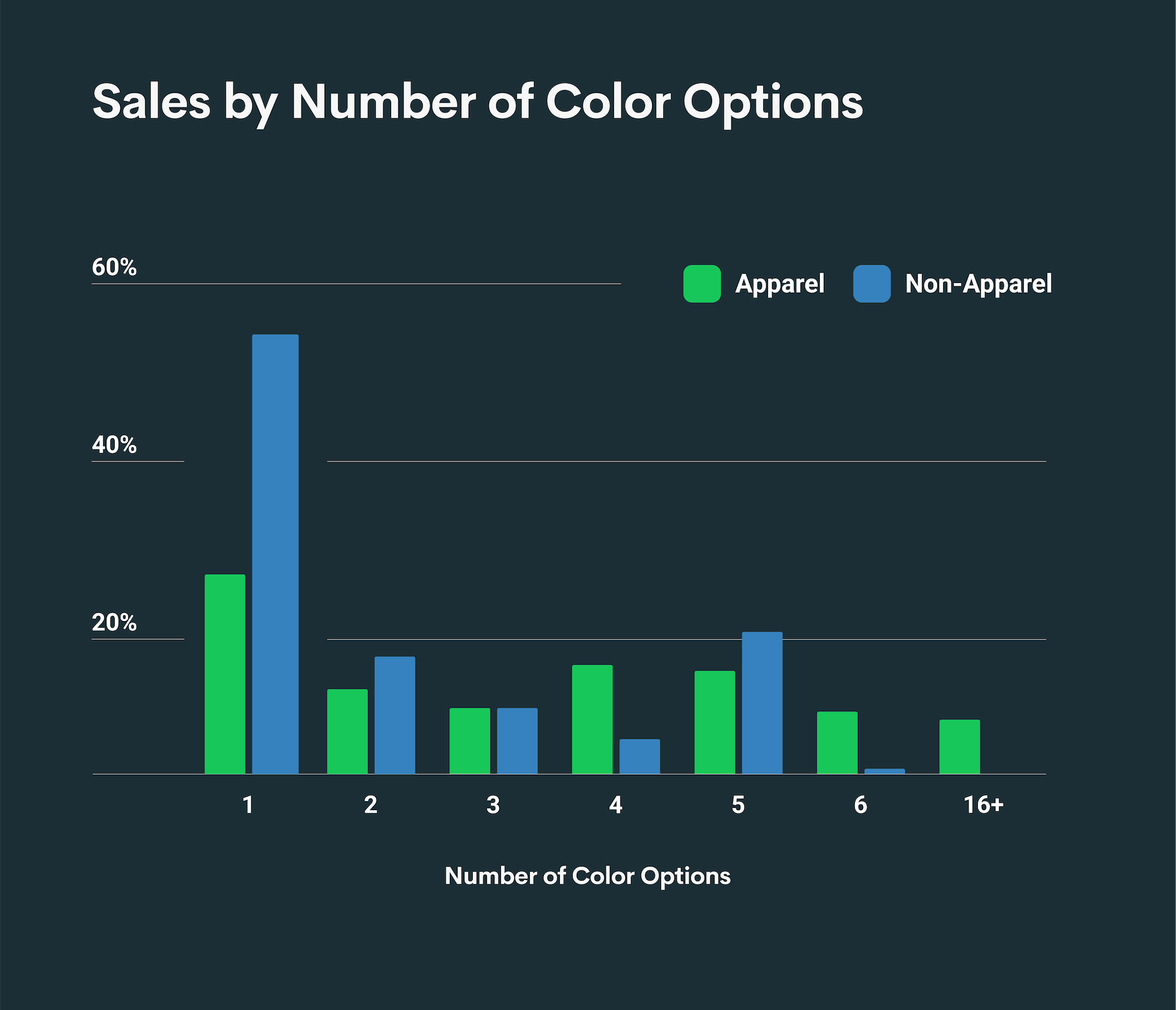
Don’t drown your customers in choices. Too many color options lead to decision paralysis and lost sales. Simplicity isn’t just a strategy – it’s the key that unlocks the door to your print-on-demand triumph.
Top trends: picking size options for your products
- Similar to colors, the solo-size choice is the winner in non-apparel categories, capturing a substantial 60% of eligible annual sales with items in home decor and mugs.
The one-size-fits-all approach is convenient for print-on-demand businesses selling accessories and various knick-knacks. It makes sense – when buying a mug, do you want to consider the size?
But here’s the twist – it’s a bit different for apparel.
Size matters more for apparel than it does for non-apparel categories. It’s not just about fitting in. It’s about standing out in rapidly changing fashion trends and product demand.
- The most popular clothing items (hoodies, t-shirts, and sweatshirts) tend to offer a range of 6-8 size options from XS–4XL. (With M, L, and XL being the most popular choices).
Diversity and inclusivity are key players for success. Consider a well-balanced range of sizes for your apparel products to promote your online store as an all-inclusive solution for a global market.
Design trends for eCommerce stores
With so many design options, placements, and types, how do you know what to go for with your own product choices? Well, we have discovered the secrets that turn products into art and art into sales. Let’s take a look.
When it comes to visuals, our print-on-demand statistics show a significant pattern.
- In general, products with 1-2 design elements outperform all others.
An element is an image, text, or any other form of graphics. An image can of course be complex and intricate, but most are not, and our data suggests that simple sells.
Data reveals that consumers appreciate clean designs on print-on-demand products, avoiding clusters of artwork on their items.
- Products rocking a single design element. Those dominate 56% of all eligible sales.
- Closely followed by products with two design elements, claiming a significant 24% share of all sales.
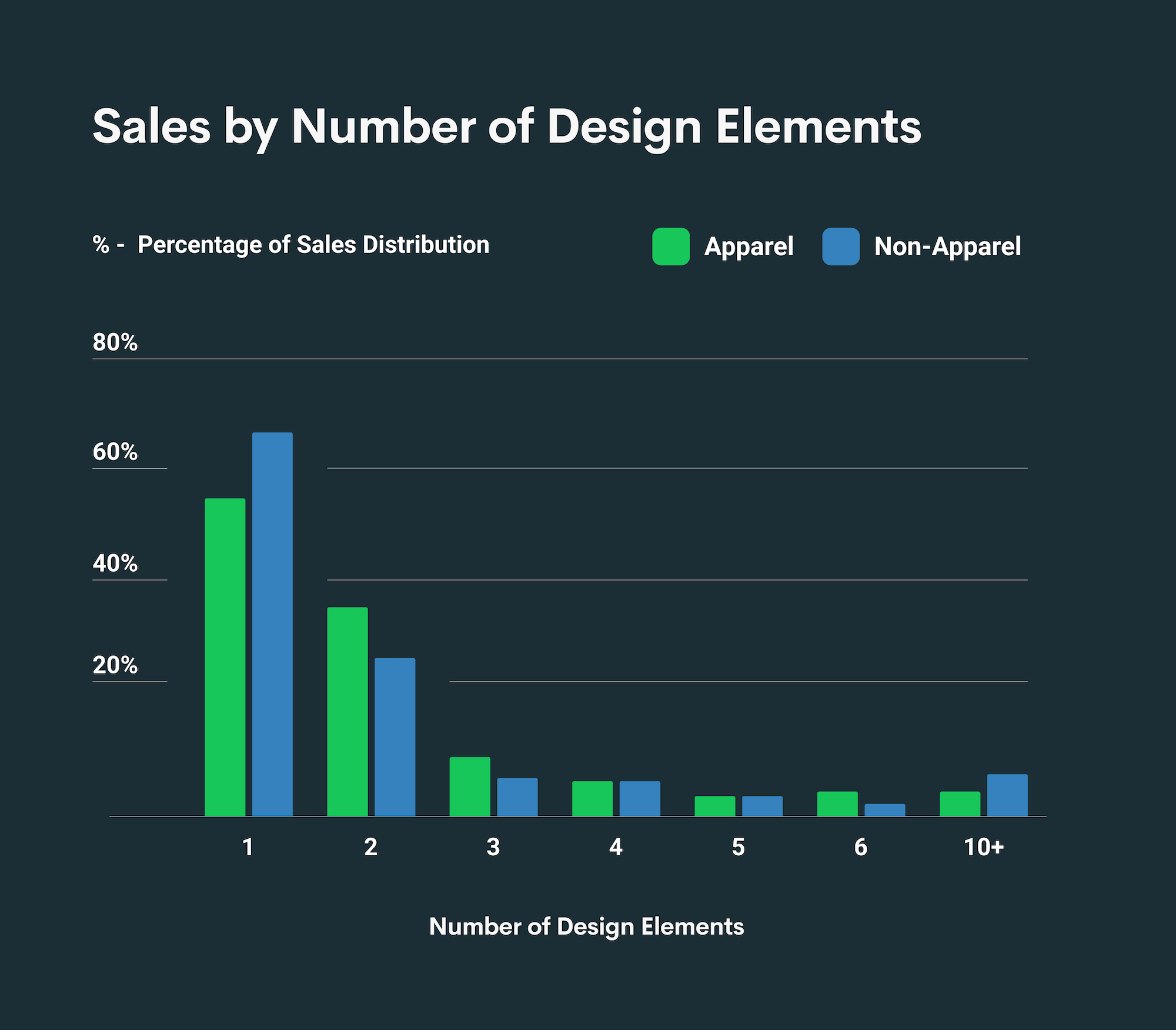
With new design software and advanced AI tools rapidly developing, deciding where to go with your artwork – from texts and patterns to abstract bursts of color – can be challenging.
Thankfully, we have some clues for success. Hold on to your pixels because the next Printify insight can be a game-changer for your design strategies and processes.
Who wins in the battle of text, pattern, or photo design?
- Turns out that across both apparel and non-apparel categories, image elements are the dominant design feature.
What does that mean for your store? The data suggests to focus your visuals around 1-2 images to offer sleek, simple, and clutter-free designs. But, as always, it’s about what makes sense to your niche. However, the numbers tell us that simpler usually does better, and that pictures often speak louder than words.
Where and how do you create these top-selling visuals?
- Most product bestsellers feature pre-designed images uploaded to our print-on-demand platform.
That means successful merchants are often perfecting their artwork using tools like Canva or Adobe Photoshop to create one-of-a-kind high-quality designs that resonate with their target audience.
However, if you don’t have the skills or time for that, try our beginner-friendly Product Creator. With a free Graphics Library, AI Image Generator, Text Editor, and Pattern Creation tool, it has everything you need to create top-notch images for your custom products.
Pricing insights for business growth
Let’s talk about prices. We’ve got some great insights into strategic product pricing and missed opportunities that could be just the missing piece that places your store among the top-earning ones.
When to have high or low-profit margins according to data
First, it’s important to understand that different products need different profit margins and pricing strategies. According to our data:
- Non-clothing products tend to have a higher profit margin than apparel.
This makes sense since little knick-knacks and home goods cost less to create, allowing you to make bigger profits. But what is an acceptable margin?
- The average profit margin for top-selling products is 40-50%. For apparel, 40% is the go-to, while mugs, candles, and paper products can have 45%, 60%, and even up to 76% markups.
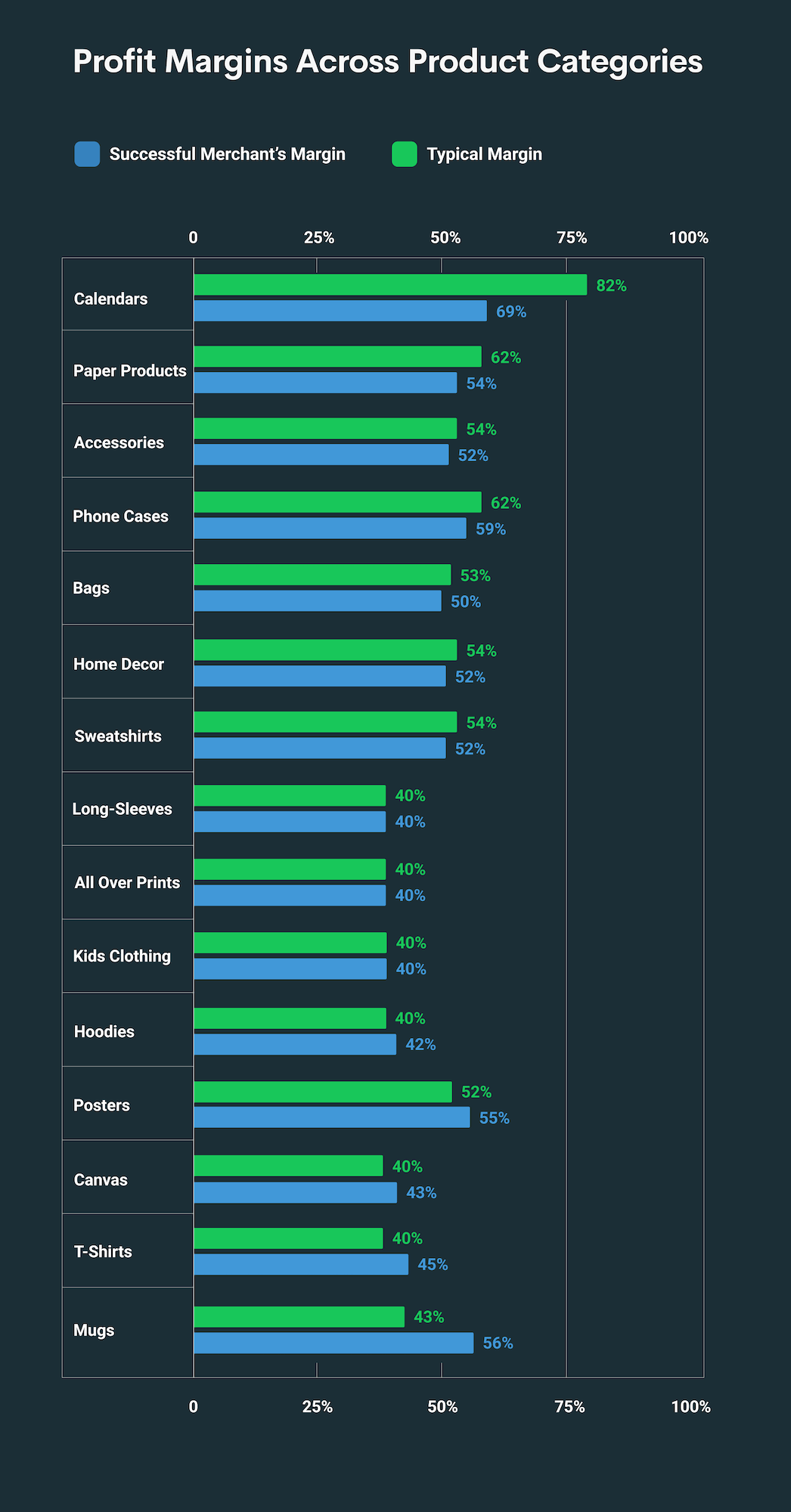
But that’s not all. While gathering this data, we spotted some golden opportunities that some of you have missed, underestimating specific products and prices consumers are willing to pay for them.
- Here’s a list of products that tend to be underpriced and have the potential for higher profit margins:
- Men’s Cotton Crew Tee (up to 50%)
- Unisex Jersey Short Sleeve Tee (up to 53%)
- Accent Coffee Mug 11oz (up to 70%)
- Unisex Softstyle T-Shirt (up to 61%)
- Ceramic Mug 15oz (up to 71%)
- Hardcover Journal Matte (up to 70%)
In the meantime, don’t overestimate certain products, pricing them too high and missing out on potential sales.
- Some products to consider for lower profit margins:
-
- Ceramic Ornament, 4 Shapes (average 40%)
- Kiss-Cut Stickers (average 40%)
- 11oz Black Mug (average 42%)
- Two-Tone Coffee Mugs, 15oz (average 42%)
- Unisex Ultra Cotton Tee (average 40%)
- Cotton Canvas Tote Bag (average 43%)
- Women’s Ideal Racerback Tank (average 43%)
- Unisex Heavy Blend™ Hooded Sweatshirt (average 40%)
Navigate pricing strategies with precision, tailoring margins for each product type. Maximizing profits on strategic choices and avoiding overpricing pitfalls will set you on the path to eCommerce success.
Read more:How to Price a Product and T-Shirt Pricing Calculator.
Insights for selling across global markets
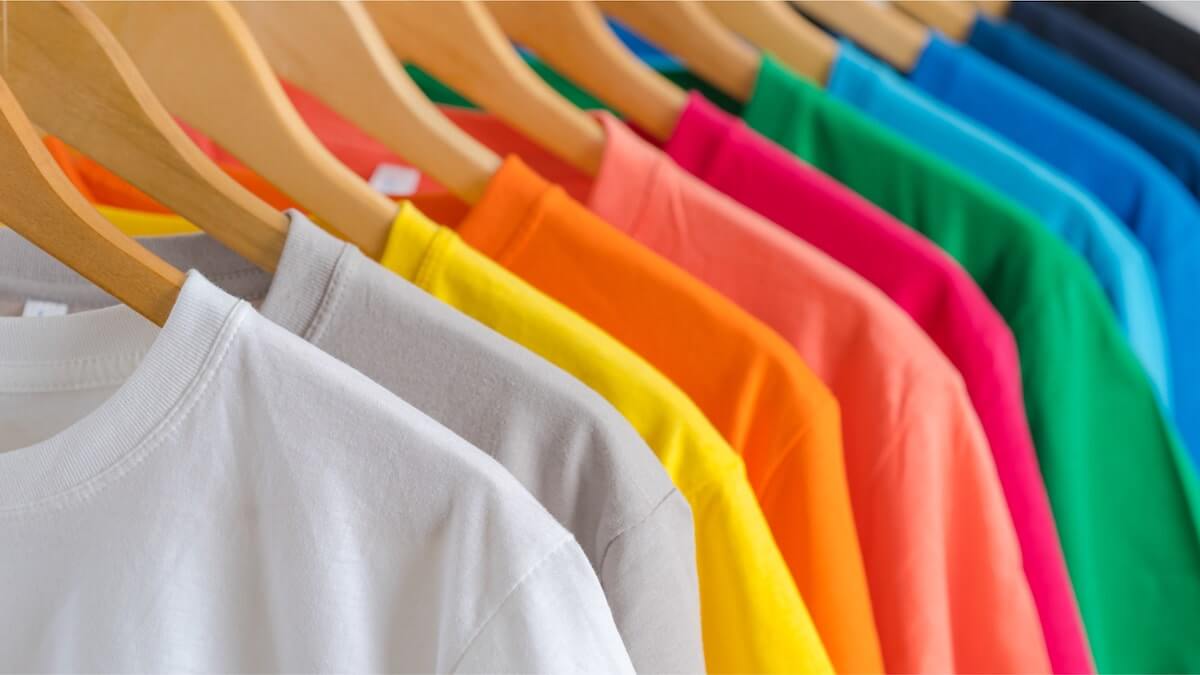
You need to adapt different strategies to conquer foreign markets, and our data is your guiding compass in this quest.
Let’s look at some valuable insights that can help you develop an effective game plan for selling globally, with a key focus on markets like Canada, Australia, the UK, Germany, as well as the biggest POD market out there – the United States.
Universal factors across all markets
While the Printify Catalog stores hundreds of clothing items to choose from, one beats them all in terms of sales and popularity across the globe:
- T-shirts reign supreme in the apparel category in all countries – closely followed by hoodies and sweatshirts.
If you want to utilize this demand and become the go-to place for tees of all kinds, keep these facts in mind:
- Black and white emerge as the most popular colors for t-shirts across all countries, with navy following close behind, reflecting a global preference for classic and versatile options.
- Sizes M, L, and XL are the preferred choices for tees, with L emerging as the most popular choice for apparel in all countries.
What colors are selling where?
The spectrum of top-selling colors is not wide (with black and white taking the lead in all apparel sales), but there are some differences depending on the product and country.
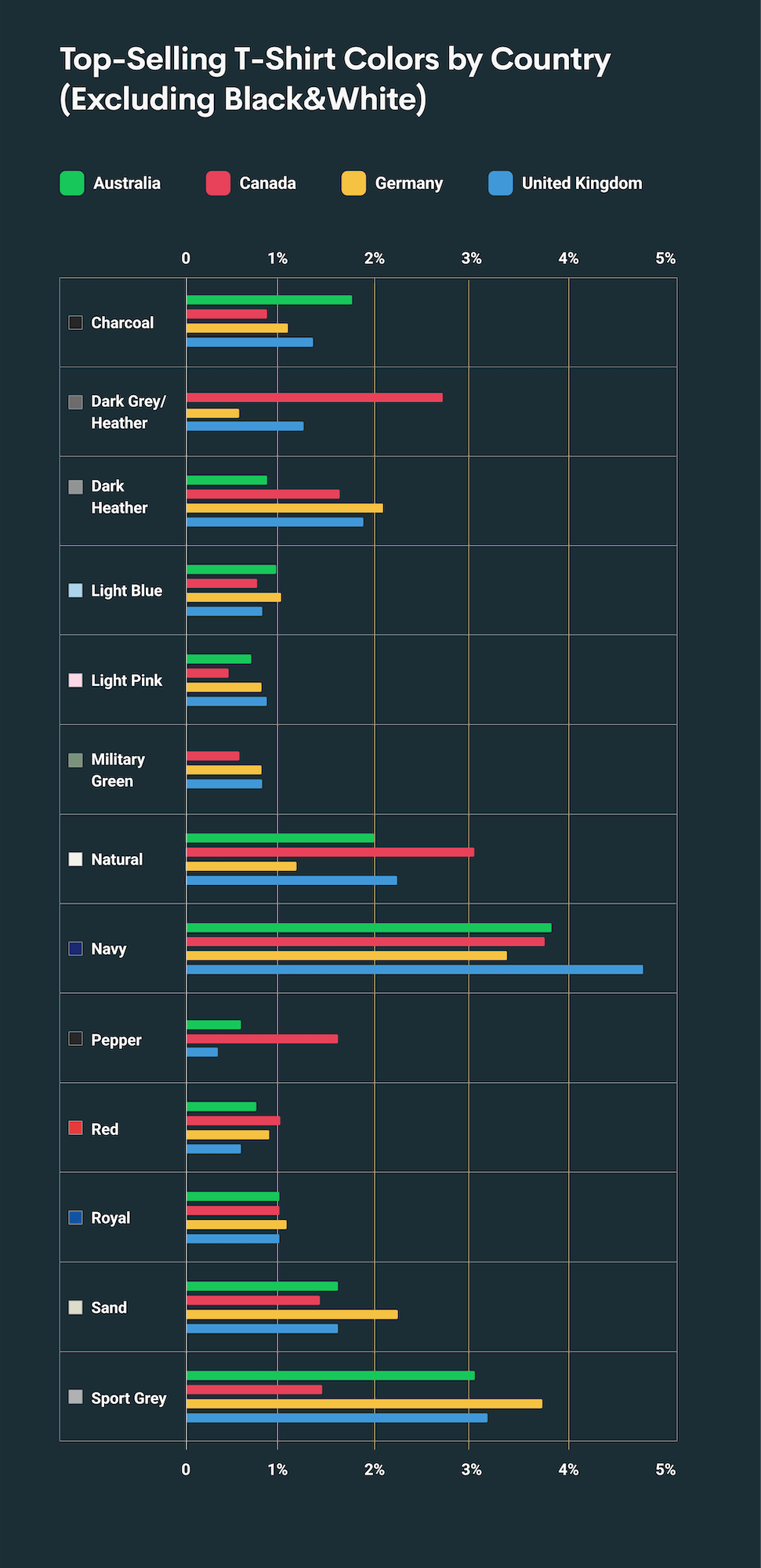
For example, if you wish to sell all three apparel bestsellers (t-shirt, hoodie, sweatshirt), it’s worth keeping an eye on sport gray.
- Surprisingly, sport gray lacks popularity in hoodies and sweatshirts across all countries, but it does maintain a somewhat sought-after status for t-shirts.
And don’t forget the dark heather and sand tones.
- Sand ranks high for tees, sweatshirts, and hoodies, especially in Germany and Australia.
- While dark gray heather is a big hit in Canada for t-shirts.
If you want to rake in sales from the Aussie market, it turns out they’re not much into forest shades.
- Military green for t-shirts and forest green for sweatshirts are reasonable hits in the United Kingdom, Germany, and Canada. However, those colors are something the Australian market is just not that interested in.
- Instead, pick more natural, charcoal, and light blue t-shirt tones for your consumers in the Land Down Under.
As your knowledge expands, so does your potential for worldwide success. Equipped with these global insights, you can tailor your offers strategically to meet specific preferences in each country.
Make informed choices for your online business and flourish in the global marketplace.
Print on Demand data insights for 2026: Key takeaways

As we wrap up our list of the latest POD trends and exclusive Printify data, let’s reflect on the main points we’ve uncovered that can help shape your business in 2026.
Even if your first sales flop, stick with the checklist, adapt your efforts, and watch your online store take off.
- Publish frequently and a lot. At least ten new products each week.
- Simplicity is key. Stick to 1-2 design elements and 1-5 color options.
- Be inclusive. Offer a range of 6-8 sizes for a diverse apparel market.
- Price your products right. The average profit margin is 40-50%. But there are more opportunities for specific products.
- Cater to global demand. Rock the global apparel market with black and white t-shirts, sweatshirts, and hoodies.
Armed with our unique data, you gain a strategic edge. Use these insights in your business, design, and marketing strategies to set sail toward growth and success in the dynamic world of Print on Demand.












